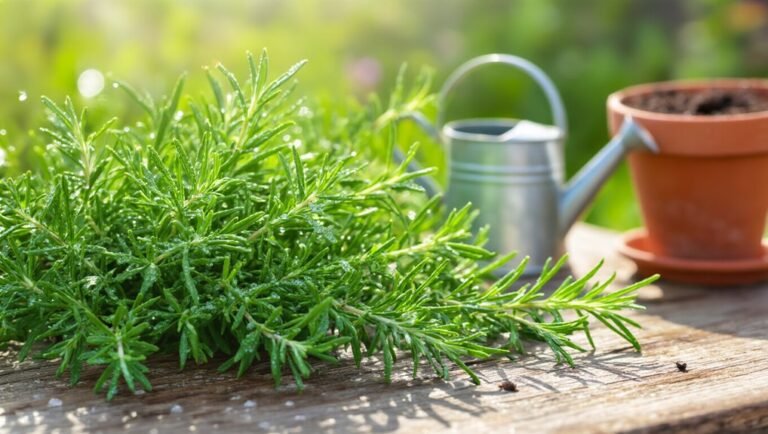To grow rosemary successfully, start by choosing the right variety for your space, like ‘Tuscan Blue’ for flavor or ‘Blue Boy’ for compact areas. Ensure you have well-draining, slightly alkaline soil with good airflow and six to eight hours of sunlight daily. Water deeply but infrequently, and fertilize with low nitrogen options. Watch for pests and root rot, and harvest regularly. Keep exploring to uncover more tips for nurturing your rosemary plants!
Key Takeaways
- Choose a suitable rosemary variety based on your space and culinary needs, like ‘Tuscan Blue’ for flavor or ‘Blue Boy’ for compact areas.
- Ensure well-draining, slightly alkaline soil with a pH of 6.0 to 7.0 for optimal growth.
- Water deeply but infrequently, allowing soil to dry between waterings to prevent root rot.
- Provide 6-8 hours of direct sunlight daily and ensure good air circulation around the plants.
- Fertilize with a low nitrogen, slow-release option in early spring to enhance flavor and plant health.
Choosing the Right Rosemary Variety
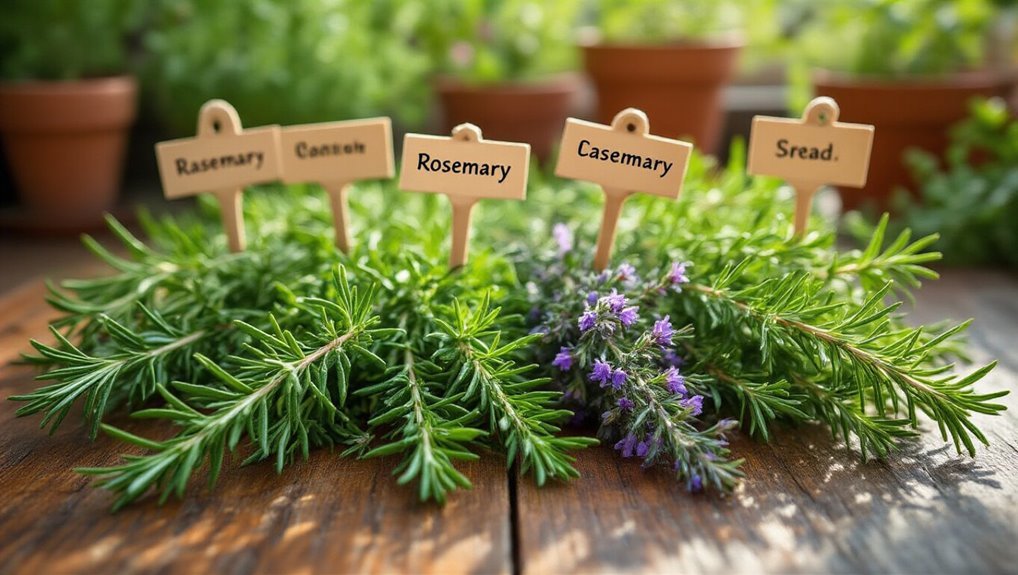
When you’re choosing the right rosemary variety for your garden, consider how you’ll use it, as different types offer unique flavors and growth habits.
If you’re looking for culinary options, ‘Tuscan Blue’ is a popular choice, known for its robust flavor and upright growth.
For a more compact option, try ‘Blue Boy,’ perfect for small spaces or containers.
If you want a trailing variety, ‘Prostratus’ is ideal for hanging baskets.
Don’t forget about ‘Arp,’ which is cold-hardy and great for colder climates.
Each variety has its own charm, so think about your garden’s aesthetic and your cooking preferences. Many gardeners enjoy indoor herb gardens because they make it easy to grow rosemary and other herbs year-round.
Choosing wisely ensures you’ll enjoy fresh rosemary for years to come!
If you’re just starting out, consider using Herb Garden Kits with Seeds and Pots to make the process even easier and more convenient.
Ideal Soil Conditions for Rosemary
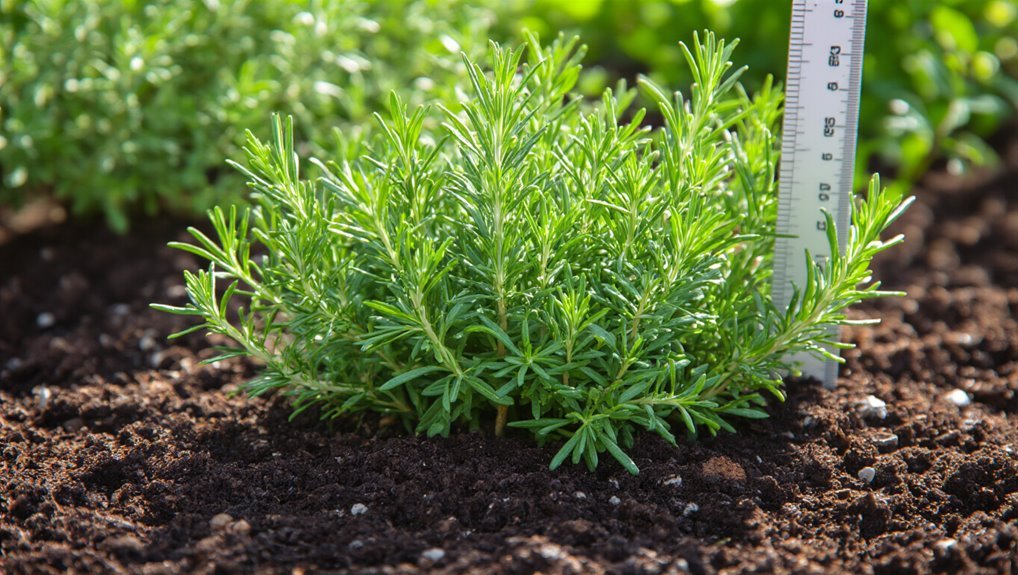
Choosing the right variety of rosemary is just the beginning; the soil you plant it in plays a significant role in its health and growth. Rosemary thrives in well-draining soil that’s slightly alkaline. Aim for a pH level between 6.0 and 7.0 to keep your plants happy.
Sandy or loamy soils work best, as they provide good drainage and prevent waterlogging. If your soil is heavy or clay-like, consider amending it with sand or perlite for better aeration. It’s also wise to incorporate organic matter, like compost, to boost nutrient levels while maintaining drainage. For even better moisture retention and weed control, consider using the benefits of mulch in your rosemary bed.
Avoid overly rich soils, as they can lead to excessive growth and poor flavor. For best results, consider starting with the best garden soil to ensure your rosemary has the ideal foundation for thriving growth. By ensuring proper soil conditions, you’ll set your rosemary up for success.
Sunlight Requirements for Healthy Growth
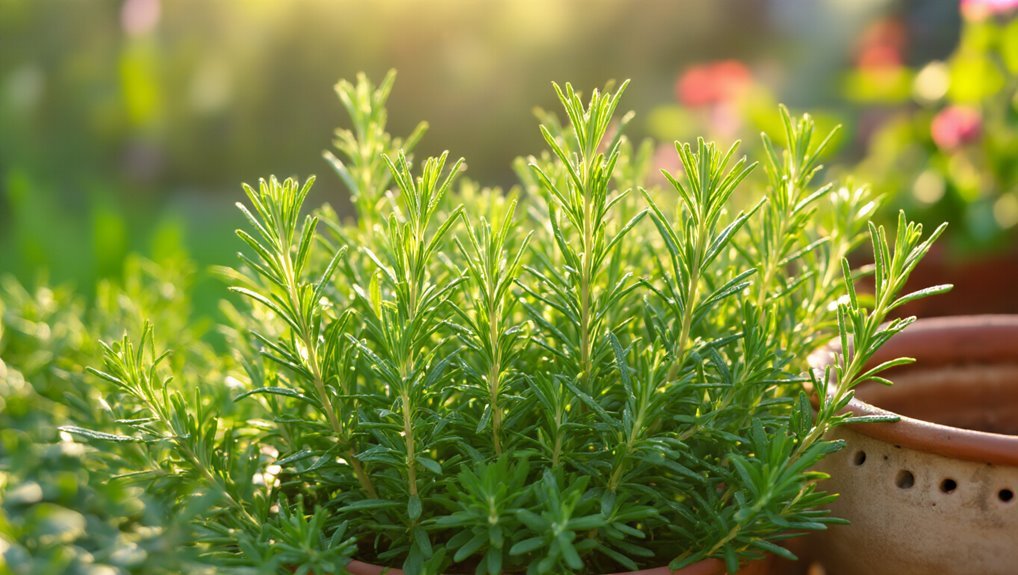
For rosemary to flourish, it needs plenty of sunlight, ideally six to eight hours of direct exposure each day. When you place your rosemary in a sunny spot, it encourages healthy growth and enhances the plant’s aromatic oils.
If you’re growing it indoors, choose a south-facing window where it can soak up those rays. Be mindful, though; insufficient sunlight can lead to leggy, weak plants that are more susceptible to pests and diseases. Using the right watering cans can also help ensure your rosemary receives adequate moisture without overwatering.
If you notice your rosemary stretching toward the light, it’s a sign it’s not getting enough sun. Consider rotating the pot regularly to ensure even exposure.
To keep your rosemary thriving, make sure you have essential garden hoses on hand for consistent and convenient watering.
Watering Techniques for Optimal Growth
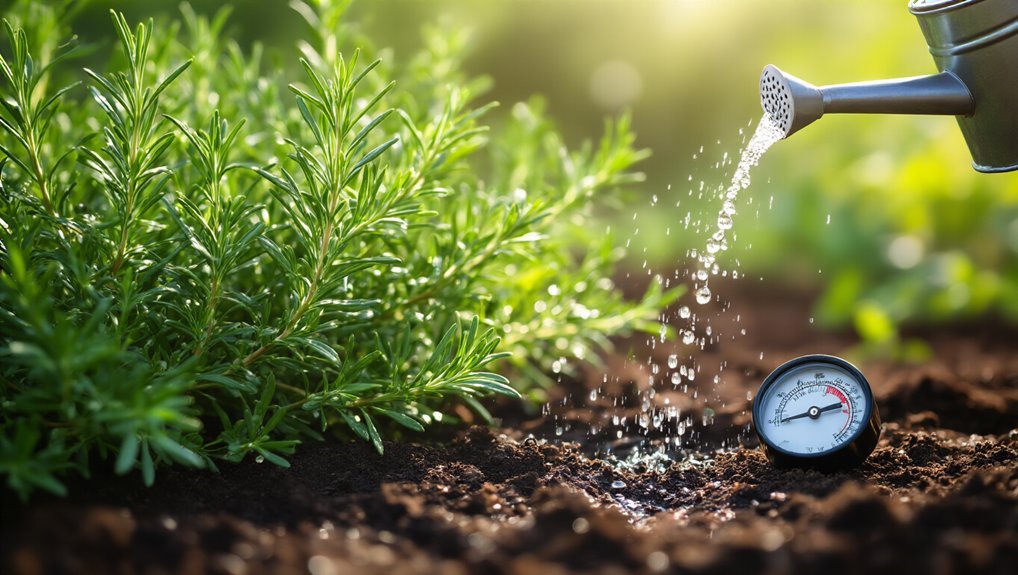
Although rosemary is drought-tolerant, proper watering techniques are essential for optimal growth. You should water your rosemary deeply but infrequently, allowing the soil to dry out between waterings. This encourages deep root development. Using soil moisture sensors can help you accurately determine when your rosemary needs water and prevent overwatering.
A good rule of thumb is to check the top inch of soil; if it’s dry, it’s time to water. During hot months, you might need to water once a week, while in cooler seasons, you can reduce frequency.
Always ensure your pot has drainage holes to prevent waterlogging, which can lead to root rot. If you’re growing rosemary in the ground, consider using mulch to retain moisture while keeping the roots cool.
If you want to monitor soil temperature for even healthier roots, you might consider using compost thermometers to ensure the conditions are ideal for your rosemary.
With the right approach, your rosemary will thrive!
Fertilizing Rosemary for Better Flavor
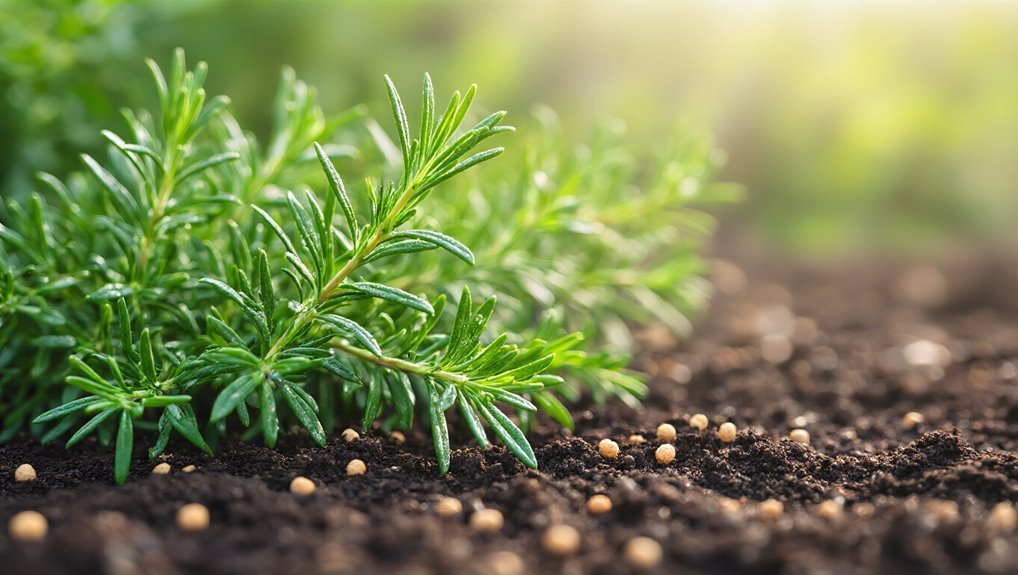
To enhance the flavor of your rosemary, it’s important to use the right fertilizers at the right time. Start with a balanced, slow-release fertilizer in early spring, when your plant begins to grow actively. This gives it the nutrients it needs to thrive. For best results, choose from the best plant food options that are specially formulated for herbs and edible plants.
Look for a fertilizer low in nitrogen, as too much can lead to excessive leaf growth but dilute flavor. Consider organic options like fish emulsion or compost, which provide a more natural boost.
Apply fertilizers sparingly, about once every month during the growing season, to avoid overwhelming your plant. Remember, rosemary thrives in poor soil, so less is often more.
Finally, always water your rosemary after fertilizing to help the nutrients penetrate the roots effectively. For an easy and effective feeding routine, you can use plant fertilizer tablets, which offer a slow-release supply of nutrients ideal for herbs like rosemary.
Pruning and Harvesting Rosemary
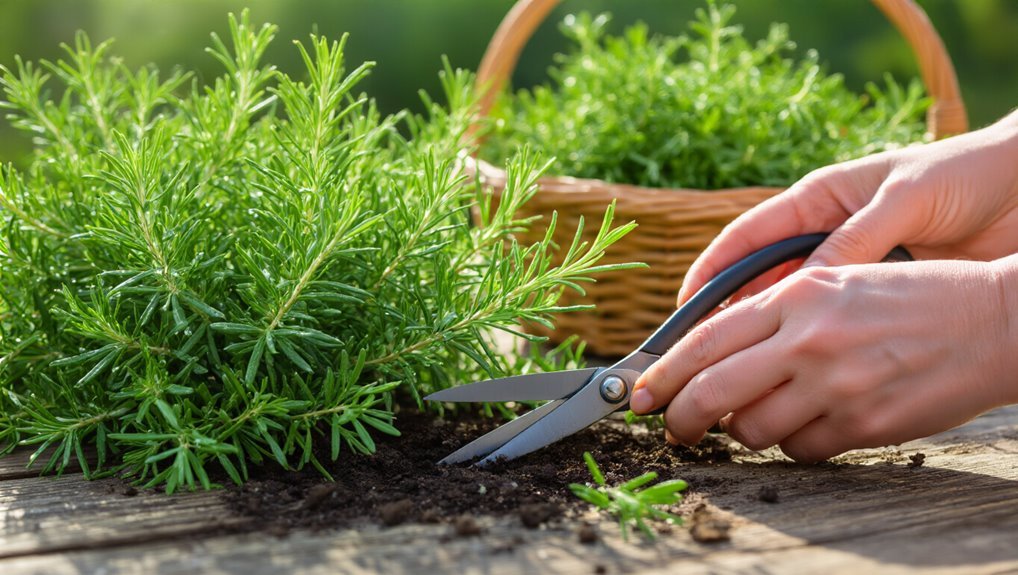
When you prune and harvest rosemary, you’re not just shaping the plant; you’re also encouraging new growth and enhancing its flavor.
Start by cutting back the stems in early spring or late summer, removing about one-third of the plant. This helps maintain a bushy shape and prevents legginess. Use clean, sharp scissors or pruning shears to make clean cuts just above a leaf node. For best results and ease of maintenance, consider investing in essential pruning shears designed specifically for gardening needs. Having gardening tool sets on hand can make all your pruning and maintenance tasks much easier and more efficient.
When harvesting, snip off sprigs as needed, ideally during the morning when the oils are most concentrated. Avoid taking too much at once; this ensures the plant remains healthy.
After pruning, consider using the fresh leaves in your cooking or drying them for later use. Enjoy the rich aroma and flavor that freshly harvested rosemary brings to your dishes!
Common Pests and Diseases to Watch For
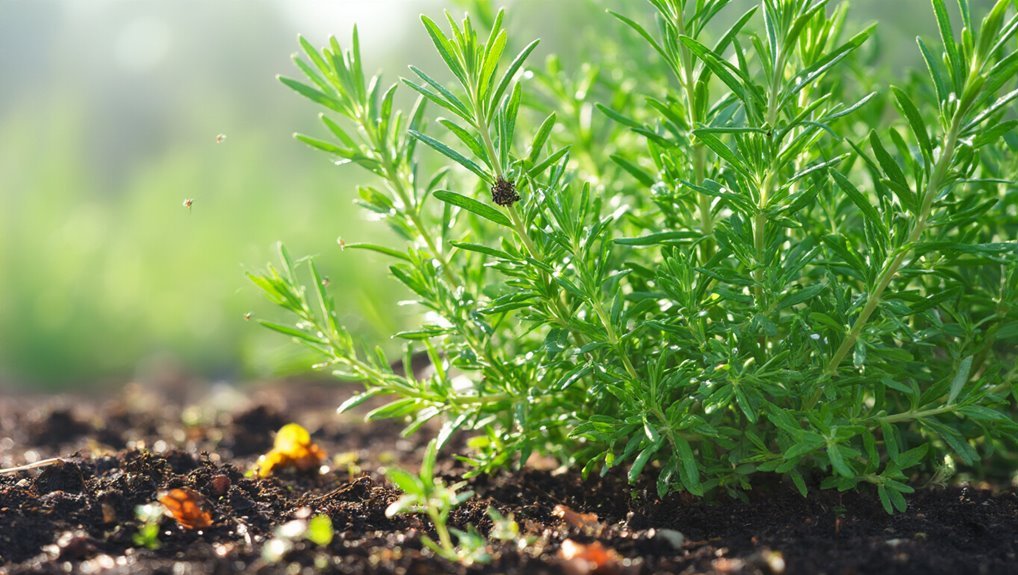
As you cultivate your rosemary, it’s crucial to keep an eye out for common pests and diseases that can threaten its health.
Here are three issues you should watch for:
- Aphids: These tiny insects suck the sap from your rosemary, leading to stunted growth. If you spot them, consider using insecticidal soap or neem oil to control the infestation.
- Powdery Mildew: This fungal disease appears as white powder on leaves, often due to poor air circulation. Ensure your plants have adequate spacing and good airflow to prevent this issue. Using Organic Pest Control Solutions can help address fungal problems without introducing harsh chemicals to your garden.
- Root Rot: Overwatering can cause root rot, which is deadly. Make sure your rosemary is planted in well-draining soil and check the moisture levels regularly.
For persistent problems, you may want to explore effective solutions for pest control products that are specifically designed to protect your plants and keep them healthy.
Stay vigilant, and your rosemary will thrive!
Frequently Asked Questions
Can Rosemary Be Grown Indoors Successfully?
Yes, you can successfully grow rosemary indoors! Ensure it gets plenty of sunlight, use well-draining soil, and maintain moderate humidity. With proper care, your indoor rosemary can thrive and provide fresh flavor for your meals.
How Long Does It Take for Rosemary to Mature?
Growing rosemary is like watching a slow dance; it usually takes about 6 to 12 months for it to mature. Patience is key, but once it’s ready, you’ll enjoy its fragrant rewards!
What Are the Best Companion Plants for Rosemary?
When you’re choosing companion plants for rosemary, consider thyme, sage, or basil. These herbs thrive in similar conditions and can enhance each other’s growth while repelling pests. Just make sure there’s enough space for each plant!
Can Rosemary Survive Winter Outdoors?
Imagine a frosty garden, where rosemary stands resilient against the chill. Yes, it can survive winter outdoors if you protect it from harsh winds and overly wet soil, ensuring its aromatic leaves flourish come spring.
How Can I Propagate Rosemary From Cuttings?
To propagate rosemary from cuttings, take healthy, 4-6 inch stems, remove lower leaves, and dip the cut ends in rooting hormone. Plant them in moist soil, keep them warm, and they’ll root in a few weeks.
Conclusion
With the right care, your rosemary can flourish like a fragrant sunbeam in your garden. By choosing the right variety, ensuring optimal soil and sunlight, and practicing proper watering and pruning techniques, you’ll cultivate a plant that not only thrives but also enhances your culinary creations. Keep an eye out for pests and diseases, and soon you’ll enjoy vibrant, flavorful rosemary at your fingertips—all while basking in the satisfaction of your gardening success!
